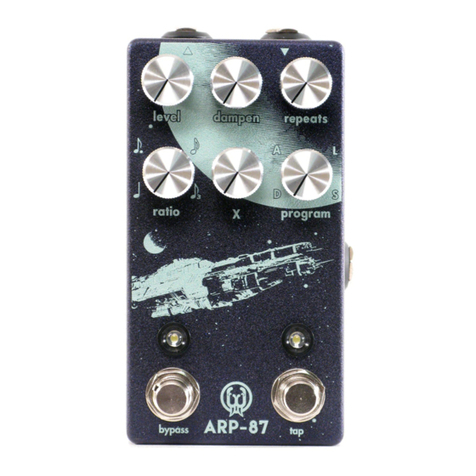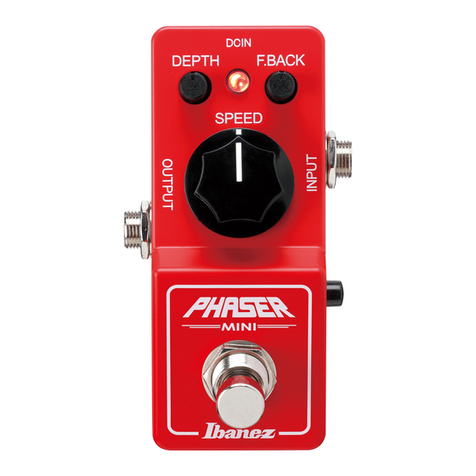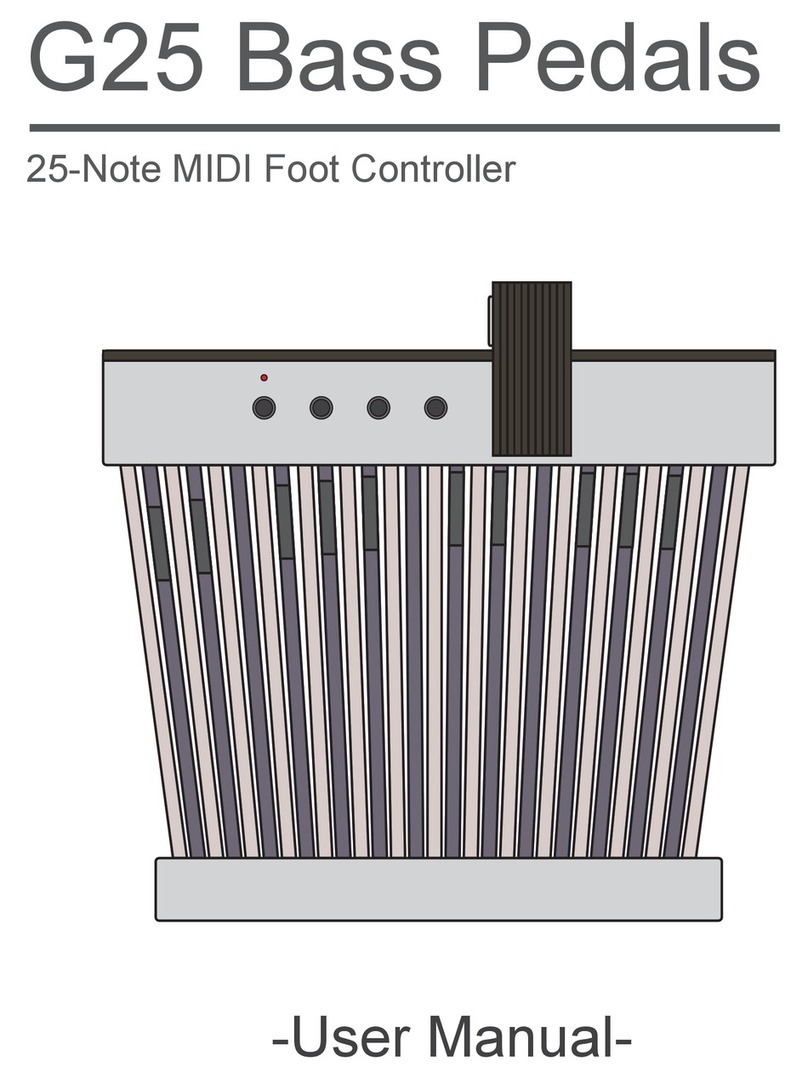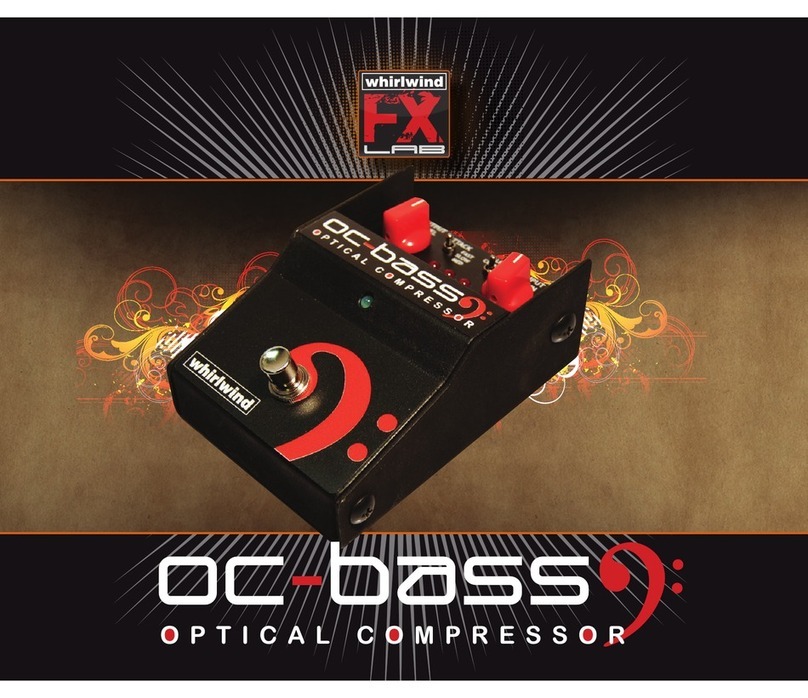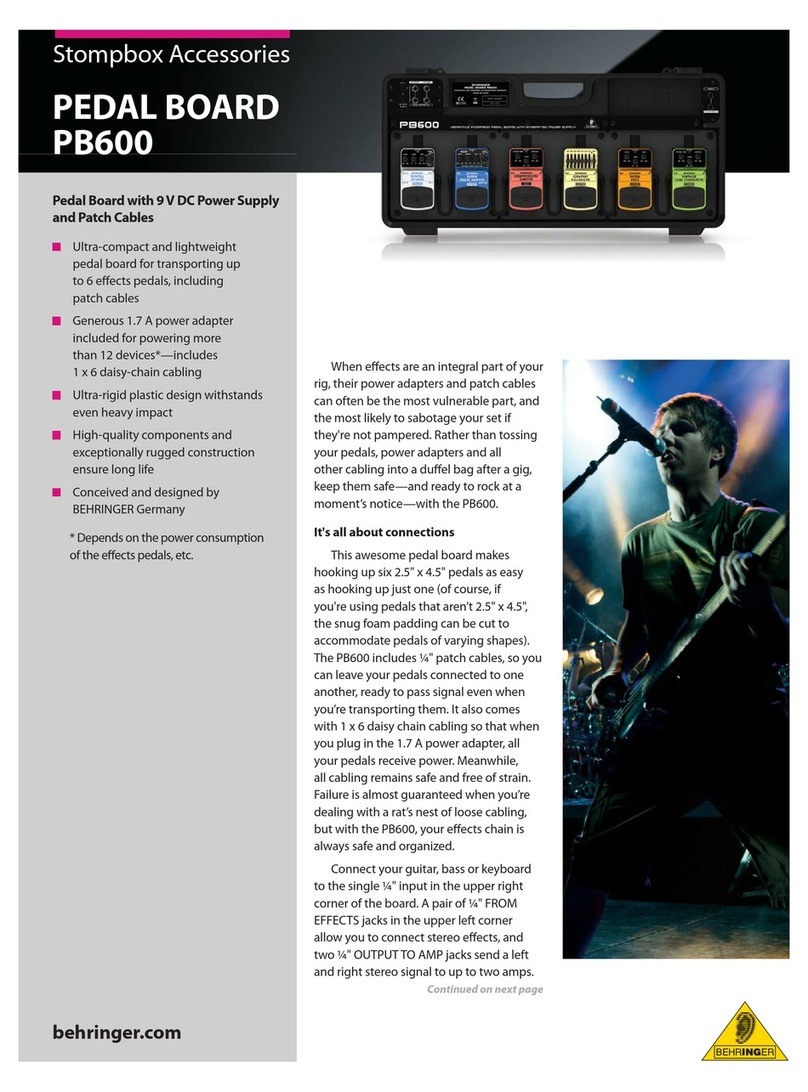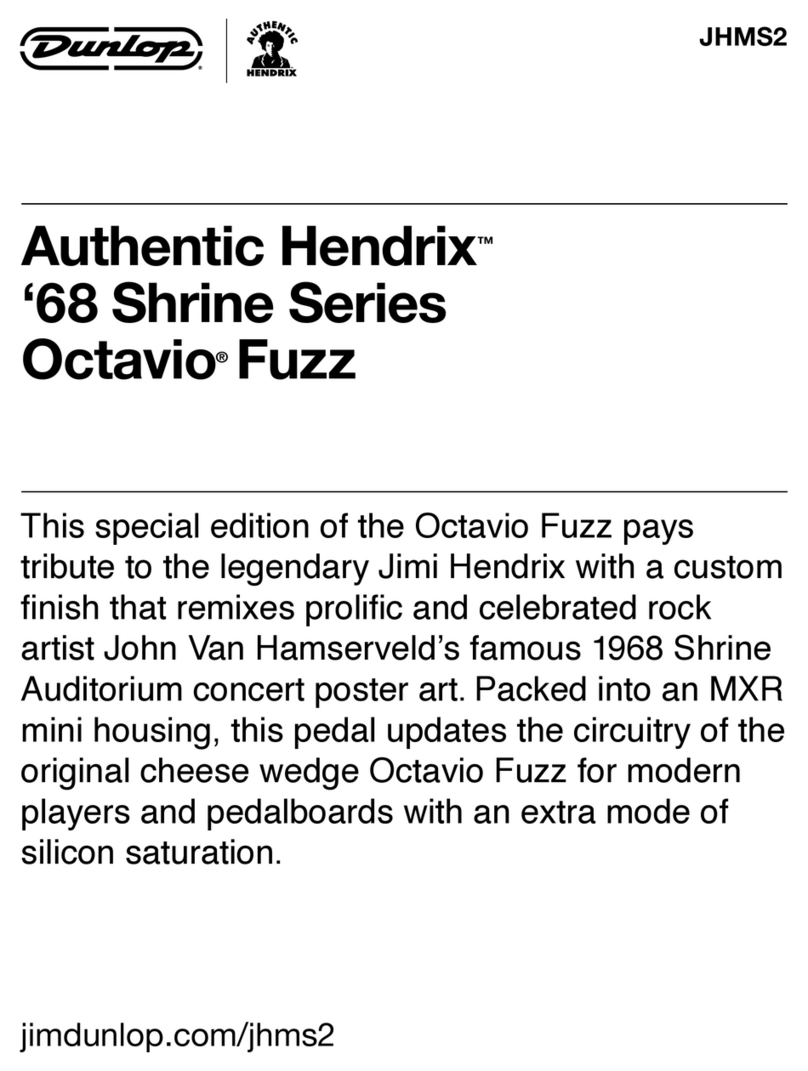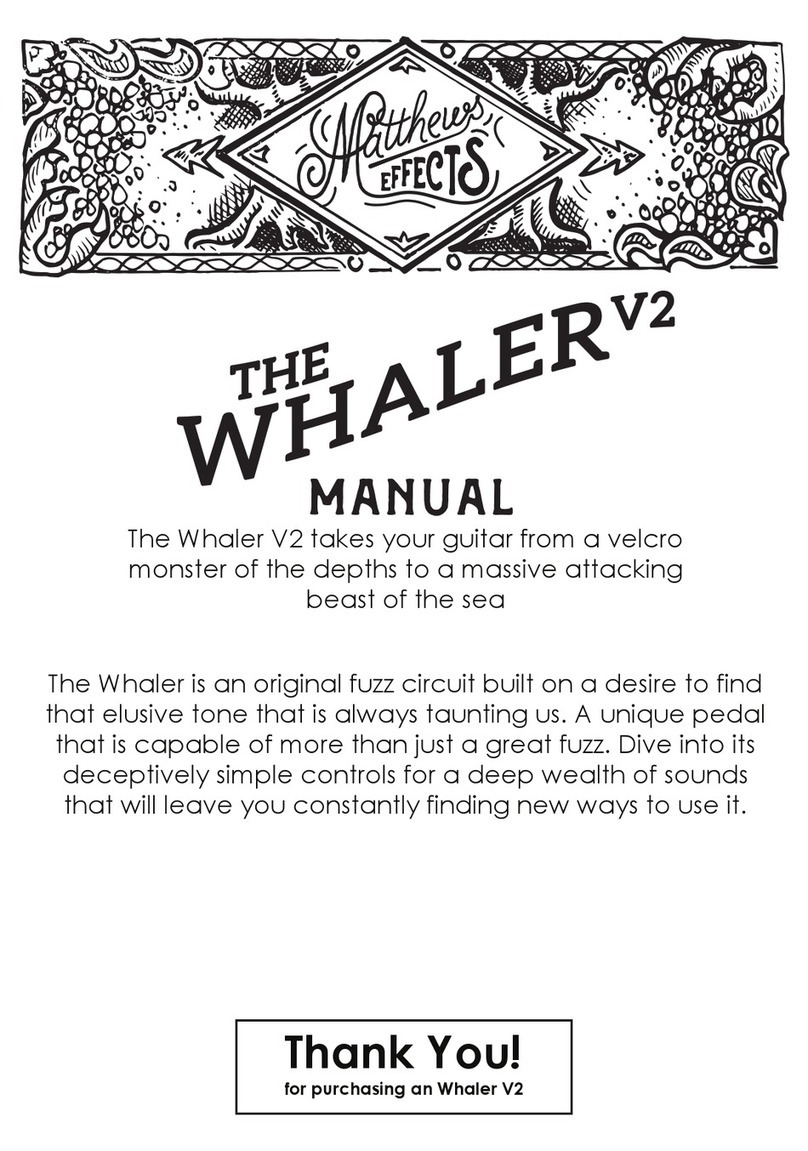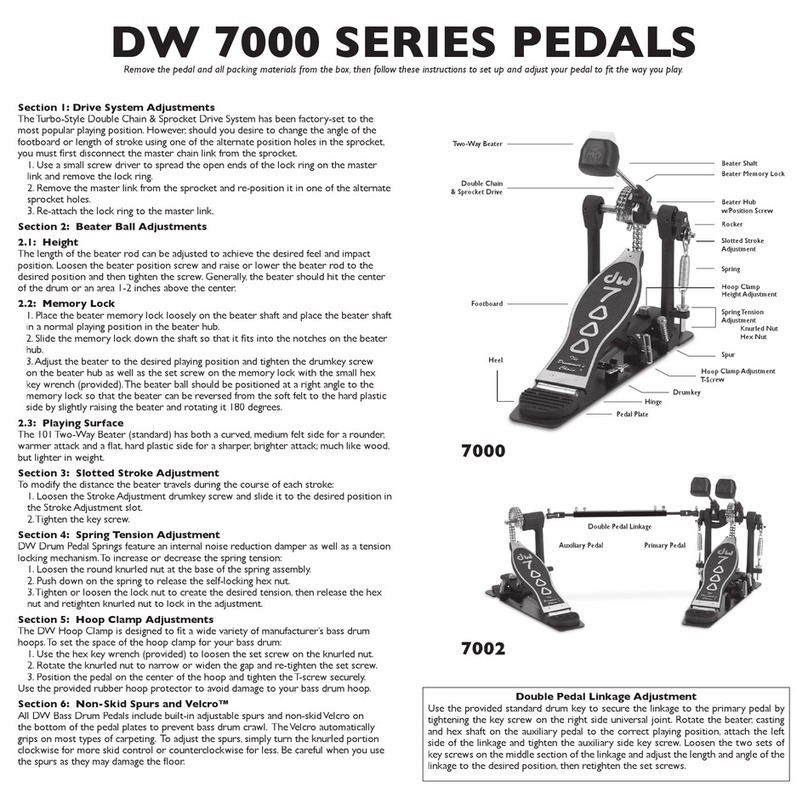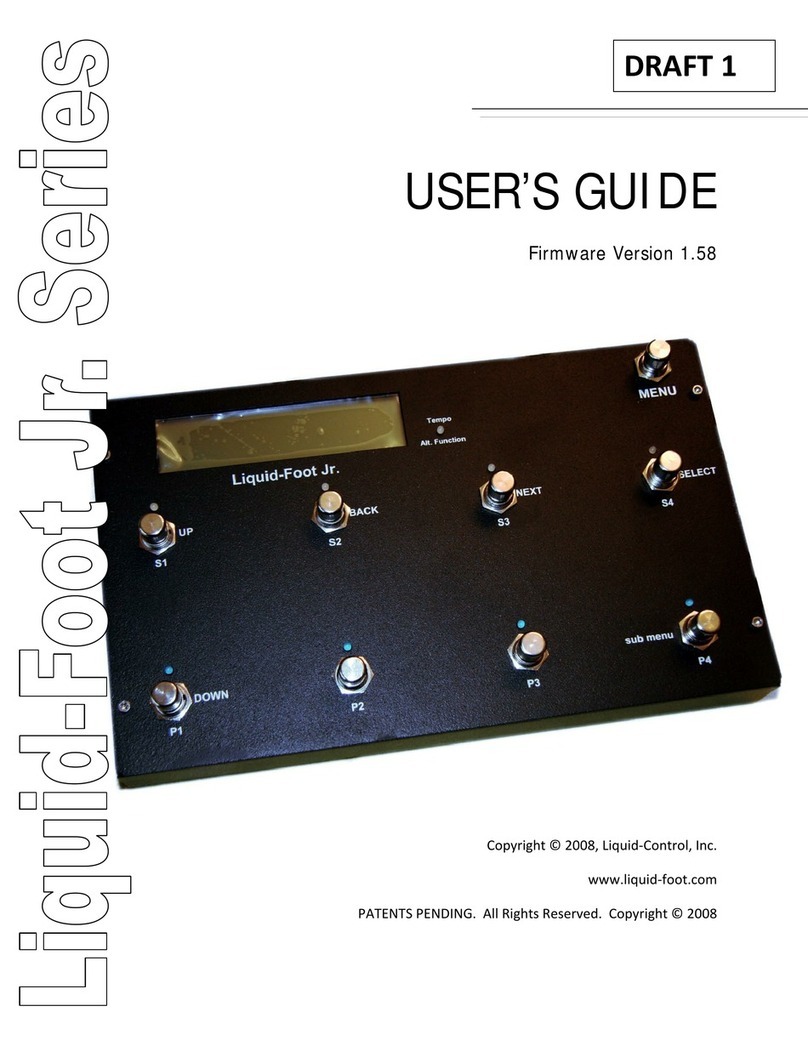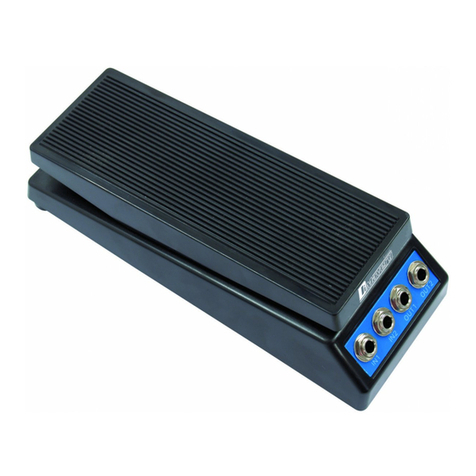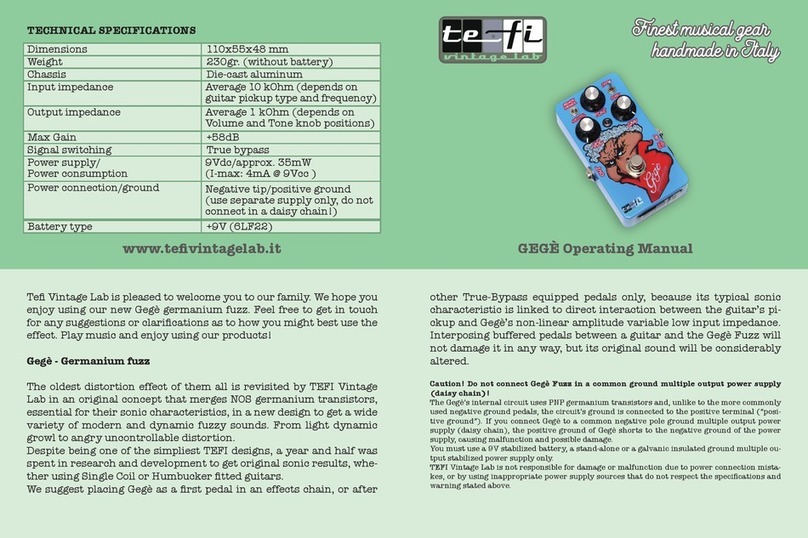stereophonic FEVER PITCH User manual

fever pitch
stereophonic orchestrator
USER MANUAL
page
effect
menu
VENTURE
series
stereophonic orchestrator
ta p
ramp
bypa ss
preset
FEvER
PTICH

I hear a symphony, and so can you.
The Alexander Fever Pitch represents a quantum leap forward for effects pedals, combining a
four-voice pitch shifter with a exible effects section.
Using the pedal is pretty simple: plug your instrument into the INPUT jack and your amplier
or other effect into the LEFT / TRS jack, power up the pedal with 9V 250mA or more, and turn
some knobs. You’ll be rewarded with expansive textures Fever Pitch’s FXCore DSP processor
and our own custom microcontroller interface.
This manual contains full technical details on the operation of this pedal.
For more information regarding rmware updates, update tools, and
software integration, please scan the code in this section to visit our
website.
BASIC OPERATION
scan me for
more info!
INPUT: Instrument input. Defaults to mono, may be set to TRS Stereo or TRS Sum using
the Global conguration menu.
RIGHT: Right stereo output. This output may be phase-inverted in the Global conguration
menu to match the output phase of your amplier setup.
LEFT / TRS: Main output. Defaults to mono output, may be set to output the left side of the
stereo output using the Global conguration menu. May also be used as a TRS
stereo output (disables the RIGHT jack) if the next effect or input is TRS stereo.
DC 9V: Center-negative, 2.1mm ID barrel jack for DC input. The pedal requires a
minimum of 250mA to operate, higher current supplies are acceptable. Do not
power the pedal from a source greater than 9.6V DC.
USB: USB mini-B connector for USB MIDI or rmware updates
MULTI: User congurable jack, used for Expression pedal (TRS only,) remote footswitch,
or MIDI input / output (requires converter unit or adapter cable.)
INS AND OUTS
MULTIINPUT DC 9V USB
CONTENTS
BASIC OPERATION ...............................................................................3
INS AND OUTS ......................................................................................3
CONTROLS & DISPLAY..........................................................................4
PRESETS ..............................................................................................5
Conducting the symphony ............................................................6
PITCH SHIFTING ...................................................................................8
REVERB AND DELAY............................................................................9
MODULATION EFFECTS........................................................................9
EXPRESSION AND RAMPING ............................................................ 10
STEREO ROUTING ............................................................................. 11
GLOBAL CONFIGURATION ................................................................. 12
MIDI..................................................................................................... 13
SPECIFICATIONS ............................................................................... 14
CHANGE LOG ..................................................................................... 14
ABOUT ALEXANDER PEDALS
Alexander Pedals builds hand-crafted eects pedals in Garner, North Carolina. Each Alexander Pedal is
meticulously voiced and tweaked by our sonic scientists to achieve sounds that are both instantly familiar yet
completely unique.
Alexander Pedals are designed by Matthew Farrow and a group of trusted players, builders, and friends.
Matthew has been building guitar pedals since the late 1990s, rst with Pharaoh Ampliers, and now with
Disaster Area Designs. Matthew has designed some of the most innovative eects units on the market,
including some big names he’s not allowed to tell you about.
Alexander Pedals was started for two reasons - to make great tones, and to do good. The great tones part you
probably have some idea about. As for doing good, Alexander Pedals donates a portion of the prots from
every pedal sold to charity, whether you buy from us or our dealers. Matthew’s younger brother Alex passed
away in 1987 of a form of cancer called neuroblastoma. Alexander Pedals honors his memory by helping in the
ght to end childhood cancer.
alexanderpedals.com
GREAT TONES. DOING GOOD.
MANUAL VERSION 1.00
FEBRUARY 2022
RIGHT LEFT / TRS

CONTROLS & DISPLAY
Fever Pitch is a pretty complex pedal under the hood, but we worked hard to make sure that it’s
easy to drive.
We combined a simple user interface with a high-resolution OLED display to get you the
maximum tweakability with the minimum frustration.
The lower left knob is an endless rotary encoder with push switch. Turn this knob to navigate
between pages of the user interface, each page has a new group of effect controls to tweak.
You can tap the encoder to switch between the delay and reverb modes, or hold it to access the
Setup, Preset Save, or Scale Save menus.
The other ve knobs adjust the parameters on the current page, and the parameter names and
values are shown on the display.
The display shows the current function and position of each knob, as well as the sound mode,
preset name, and page name. If you’re using an expression pedal, the display will also show
the pedal position while it’s moving.
PRESETS
How do you make quick changes on a pedal that has 9+ knobs? PRESETS. Fever
Pitch allows you to save up to 32 presets that contain the entire state of the pedal.
Loading a preset recalls all knob positions, sequence steps, sequencer settings, and
expression pedal mappings.
To load a preset, hold the BYPASS / PRESET footswitch. You can set the number of
available presets in the Setup Menu, from 1 to 8. You can also set the pedal to access
the upper banks of presets (9-16, 17-24, 25-32) in the same menu. This allows you to
use multiple banks of presets for different gigs, bands, instruments, whatever you like.
You can also use an external MIDI controller to load any preset from 1-32, regardless of
how the Setup Menu is congured.
To save a preset, rst use the pedal knobs to tweak the sound, then hold the Page
knob. Press and hold the BYPASS / PRESET footswitch to enter the save menu.
If you want to save to the current preset, you can just hold down the BYPASS /
PRESET footswitch again. If you prefer to rename the preset, turn the Page knob to
select a character in the name and then tap the Page knob to edit that character. Use
the Page knob to select the preset number and edit to change the save location.
1 FEVRPTCH
CANCEL
SAVE TO
1 FEVRPTCH
EDIT PRESET NAME
TURN TO SELECT
CHARACTER OR
PRESET
TAP TO SELECT
CHARACTER OR
NUMBER TO EDIT
page
effect
menu
VENTURE
series
stereophonic orchestrator
ta p
ramp
bypa ss
preset
F
F
E
E
v
v
E
E
R
R
P
P
T
T
I
I
C
C
H
H
CONTROL KNOBS
ADJUST PARAMETERS
AS SHOWN ON DISPLAY
PAGE KNOB
TURN TO SELECT CONTROL PAGE
TAP TO SELECT REVERB OR DELAY
HOLD TO ACCESS MENU
TAP / RAMP SWITCH
TAP TO SET TEMPO
HOLD TO FIRE RAMP
BYPASS SWITCH
TAP TO BYPASS OR ENGAGE
HOLD TO LOAD NEXT PRESET
INPUT
MONO OR TRS
STEREO INPUT
RIGHT
R STEREO OUTPUT
L / MONO
L STEREO OR
MONO OUTPUT
MULTI
EXPRESSION
PEDAL OR MIDI
1 FVRPITCH
LVLA LVLB LVLC LVLD
DRYMAIN
PAGE NAME PAGE
PRESET
NAME
PRESET
NUMBER
CONTROL NAMES DISPLAY BARS
EXP
EXPRESSION VALUE
DATA KNOB
ADJUST PARAMETERS
AS SHOWN ON DISPLAY
OR SET MENU OPTIONS

Conducting the symphony
Fever Pitch is an exciting an unique device, made up of a customized chain of cascading eects modules. Each page of the user interface allows you, the player, to interact with dierent parts of the pedal to tailor
the sound as you see t.
The basic structure of the Fever Pitch eect is: Input -> Four Stereo Pitch Shifters -> Reverb / Delay -> Stereo Tremolo / Pan -> Stereo Chorus / Vibrato
Turn the knob to the left of the display to select a new page of controls - the small boxes at the bottom of the display indicate which page you’re currently accessing. The display will then change to show the
various controls available on the current page, as well as their settings.
MAIN PAGE
Sets the volume levels for each of the
four pitch shift voices, as well as the
volume level for the dry / unaected
input signal.
TUNING PAGE
Sets the pitch tuning for each of the
shift voices. Turn the lower-right knob
to access preset or custom tuning
scales.
PAN PAGE
Sets the stereo panning level for each
of the four pitch shift voices, as well as
the dry signal panning. Pan controls
are disabled if output is set to mono.
reverb PAGE
Sets the parameters for the built-in
reverb eect. Tap the mode knob to
replace the reverb with a delay eect.
mod.fx PAGE
Sets the parameters for the built-in
stereo tremolo / pan and chorus
eects. Turn the lower-right knob to
select the tremolo or pan mode.
misc PAGE
Sets master volume and tone controls,
as well as the ramp rate and ramp
trigger type. The lower-right knob
enables “detuning” for any pitches set
to unison.
INPUT
MONO OR
TRS STEREO
MIX CONTROLS PAN CONTROLS
OUTPUT MIXER MOD FX R OUTPUT
MONO
L OUTPUT
MONO OR
TRS STEREO
INPUT
SWITCHING SUM
PITCH
SHIFT
A
PITCH
SHIFT
B
PITCH
SHIFT
C
PITCH
SHIFT
D
A MIX
B MIX
C MIX
D MIX
SUM
REVERB
DELAY
MIX TO REVERB
DRY PAN
A PAN
B PAN
C PAN
D PAN
SUM
SUM
VOLUME
VOLUME
TONE
TONE
STEREO
CHORUS
VIBRATO
STEREO
TREMOLO
PAN
DRY MIX

REVERB AND DELAY
We’ve incorporated a exible time-based eect section to ll out your sound with Fever Pitch.
The pitch shifters and dry signal all feed a reverb and delay engine with stereo capabilities.
Tap the PAGE knob to switch between Reverb and Delay modes, as shown on the REVERB /
DELAY page.
PITCH SHIFTING
Dialing in usable musical intervals can be challenging, so we’ve given you a little help.
Navigate to the TUNING page and turn the lower right knob to select from one of our
preset scales. The intervals listed below are in semitones from your input pitch.
UNI: 0, 0, 0, 0 MIN1: 0, +3, +7, +12
OCT1: -24, -12, +12, +24 MAJ2: -12, -7, 0, +4
OCT2: -12, +12, -12, +12 MIN2: -12, -7, 0, +3
O5TH: -12, -7, +7, +12 MAJ7: 0, +4, +7, +11
5THS: -7, 0, 0, +7 MIN7: 0, +3, +7, +10
MAJ1: 0, +4, +7, +12 OCT5: -12, -7, -12, -7
You can also create your own custom scale that will be available for use in any preset.
Turn the lower right knob until one of the User scales is shown (USR1-4,) then tweak
the intervals. Hold down the PAGE knob, then keep it held until the scale saved
message appears.
Finally, don’t forget you can just manually input any pitches you like! You don’t need to
use the scales at all, they are just here to help.
Now that we’ve seen the big picture, let’s explore some of the hidden details in Fever
Pitch: the heart of the pedal is the pitch-shifting section, with four independent voices.
1 FEVRPTCH
LVLA LVLB LVLC LVLD
DRYMAIN
1 FEVRPTCH
TUNA TUNB TUNC TUND
SCALTUNING
Use the MAIN page as a mixer to set the
blend of voices you’d like to hear. You can dial
in any ratio of voices, including all wet or just
the dry signal.
+12 -12 +24 ----
USR2
Each shifter has its own tuning control that
ranges from +1 to -1 octaves, as well as +2
and -2 settings.
These are shown on the display in half-steps
(semitones) from -24 to +24.
At unison pitch, the display will show “----.”
1 FEVRPTCH
PANA PANB PANC PAND
DRYPPAN
^
The PAN page allows you to position each
voice across the stereo spectrum. The display
shows “^” when a voice is centered in the
stereo eld.
MODULATION EFFECTS
We’ve also packed two independent modulation eects into the output section of Fever
Pitch. Use the MOD.FX page to dial them in.
REVB - reverb decay time
PDLY - reverb pre-delay time
TONE - reverb tone and damping
RMIX - reverb mix
TDIV - not used in reverb mode
1 FEVRPTCH
REVB PDLY TONE RMIX
TDIV
REVERB
----
REPT - delay repeat / feedback
TIME - delay time
DPAN - delay signal pan position
DMIX - delay mix
TDIV - tap division (TRIP, 8TH, DOT8, QTR)
or disable MIDI clock (NCLK)
1 FEVRPTCH
REPT TIME DPAN DMIX
TDIVDELAY
DOT8
^
Fever Pitch will respond to tap tempo and MIDI clock in delay mode only. Set the Tap
Division to NCLK to disable MIDI clock.
TREM - tremolo / pan speed
DPTH - tremolo / pan depth
CHOR - chorus / vibrato speed
DPTH - chorus / vibrato depth
MODE - tremolo / pan mode
1 FEVRPTCH
TREM DPTH CHOR DPTH
MODEMOD.FX
PAND
The tremolo / pan eect has four dierent modes:
TREM: tremolo eect on wet signals, both left and right channels have the same modulation
PAN: panning eect on wet signals, left and right channels have opposite modulation
TR+D: tremolo eect on wet and dry signals, this produces the most intense tremolo
PN+D: panning eect on wet and dry signals, this produces the most intense panning.
The modulation eects do not respond to tap tempo or MIDI clock.
